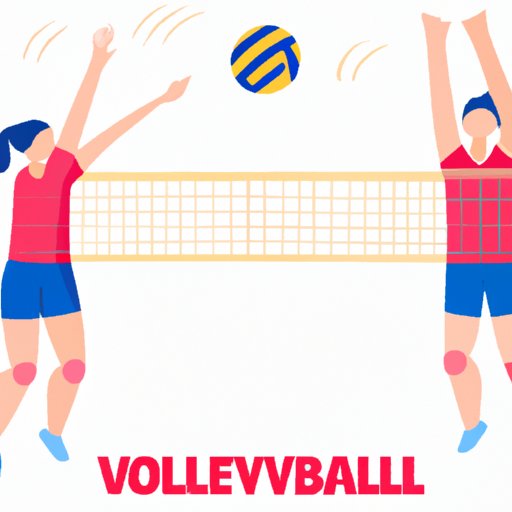
Introduction
Volleyball is a popular sport enjoyed by millions of people worldwide. It is a fast-paced, team-oriented game that is easy to learn and rewarding to master. In this article, we will provide a step-by-step guide on how to play volleyball, from the basics to advanced techniques. Whether you’re a complete beginner or a seasoned player looking to improve your skills, this guide will help you get the most out of your volleyball experience.
The Basics of Volleyball: A Step-by-Step Guide for Beginners
The three main components of volleyball are serving, bumping, and spiking. These are the fundamental skills that every player must learn in order to play the game effectively.
Serving: The serve is how the ball is put into play at the beginning of each rally. There are two main types of serves: the underhand serve and the overhand serve. To perform an underhand serve, stand with your feet shoulder-width apart, hold the ball in your non-dominant hand, and swing your other arm back and then forward to hit the ball with your fist. For an overhand serve, toss the ball high in the air with your non-dominant hand, jump, and hit the ball with your dominant hand, using a basic hand contact technique.
Bumping: Also known as a pass, the bump is used to receive the ball from the other team’s serve or hit. To bump, stand with your legs shoulder-width apart, bend your knees, and contact the ball with your forearms.
Spiking: The spike is an attacking move used to hit the ball over the net and score points. To spike, approach the ball, jump, contact the ball with your dominant hand above your head and then hit it downward in a forceful motion.
When practicing each of these moves, it is important to focus on proper technique and avoiding common mistakes, such as improper footwork or poor timing.
Mastering the Mental Game: Tips for Staying Focused on the Court
In addition to physical skills, volleyball requires mental fortitude. Staying focused, calm, and engaged during games is crucial to success. Here are some tips and strategies to help:
Visualize: Before a game, take some time to visualize success. Picture yourself executing the moves flawlessly and winning points. This can help build confidence and reduce anxiety.
Breathe: Taking slow, deep breaths can help calm your nerves and increase focus. Try inhaling for three seconds, holding for a second, and exhaling for three seconds.
Stay Positive: Volleyball is a game of momentum, and negative thoughts can quickly derail your performance. Focus on the positive aspects of your play and celebrate your successes, however small they may be.
Setting Yourself Up for Success: How to Practice Volleyball at Home
Practicing volleyball at home is a great way to improve your skills and stay in shape. Here are some exercises and drills you can do solo:
Wall Passes: Find a wall and practice passing the ball to the wall, then receiving it back. This helps improve timing and accuracy.
Footwork: Set up cones or markers and practice running and changing direction around them. This helps develop agility and coordination.
Squats and Lunges: Volleyball requires strong leg muscles for jumping and other moves. Do squats and lunges to build strength and power.
Advanced Volleyball: Tips for Taking Your Game to the Next Level
Once you have mastered the basics, there are a variety of more complex moves and strategies you can use to elevate your game. Here are a few:
The Roll Shot: This is a type of attacking move that involves lightly tipping the ball over the net to catch the other team off guard.
The Drop Shot: This is another attacking move that involves hitting the ball downward just over the net, causing it to drop quickly and making it difficult for the other team to return.
Blocking: Blocking is an important defensive move used to prevent the other team from scoring on their attack. To block, jump and use your hands to block the ball.
When practicing advanced moves, it is important to have a solid foundation in the basics and to practice with a partner or team to improve timing and coordination.
Avoiding Common Mistakes: What Not to Do When Playing Volleyball
Beginner volleyball players often make certain common mistakes that can slow down their progress or even result in injury. Here are some tips for avoiding these mistakes:
Don’t use your wrists: When hitting or passing the ball, use your forearms. Using your wrists can result in poor contact and lead to injury.
Don’t cross the center line: Stepping over the center line on the court is a violation and can result in a point for the other team.
Don’t stand too close to the net: Being too close to the net can result in faulty contact and make it difficult to recover for the next play.
Volleyball Training: How to Get Fit for the Season
Physical fitness is an important aspect of volleyball, and training regularly can help improve performance and reduce the risk of injury. Here are some exercises and activities to include in your training regimen:
Cardio: Running, biking, or other forms of cardio can improve endurance and stamina on the court.
Weight Lifting: Strength training can improve muscle tone and power for attacking and blocking.
Stretching: Stretching can help improve flexibility and reduce the risk of injury from sudden movements on the court.
Creating a training plan and tracking progress can also help keep you motivated and on track to success.
Conclusion
Learning how to play volleyball can be a fun and rewarding experience. From the basics of serving, bumping, and spiking, to more advanced strategies and moves, there is always room for improvement. Remember to stay mentally focused and physically fit, avoid common mistakes, and set achievable goals for yourself. With practice and dedication, you can become a skilled and confident volleyball player.




